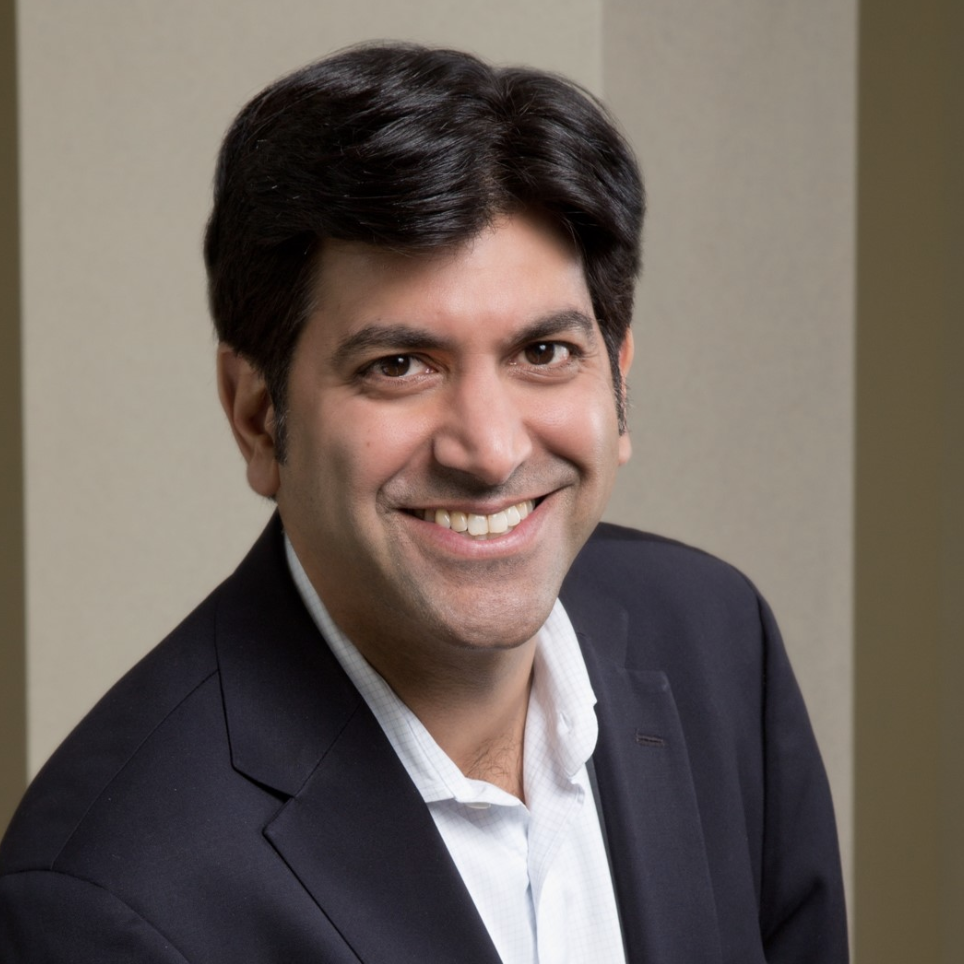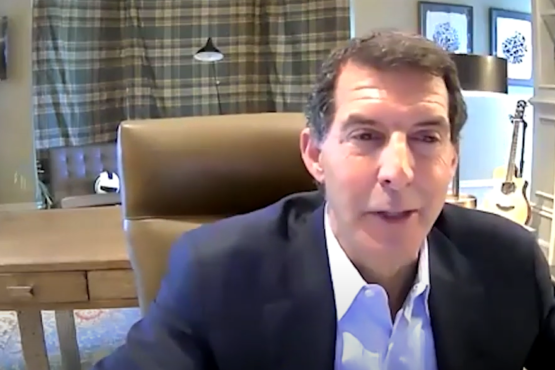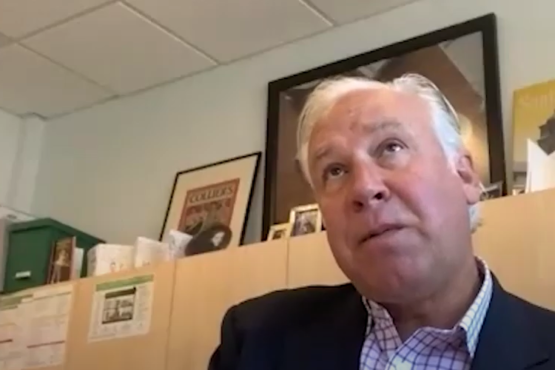Aneesh Chopra is best known as our nation’s first U.S. Chief Technology Officer, serving from 2009 to 2012. During his time in the White House, President Obama said, “Aneesh found countless ways to engage the American people using technology, from electronic health records for veterans, to expanding access to broadband for rural communities, to modernizing government records.” Today, Aneesh serves as president of CareJourney, which harnesses open data methodologies and APIs, to provide market intelligence and actionable insights, that help players and providers. Aneesh is constantly pushing the envelope to increase access to data, to empower patients and care providers. He has unique insights into how government can facilitate innovation in the private sector.
Bill Frist: Welcome to A Second Opinion Podcast, where we are rethinking American health. I’m your host, Senator Bill Frist. To make sense of all the dynamic perspectives in healthcare, you need a trusted source engaging at the intersection of policy, medicine, and innovation. You need A Second Opinion, a podcast where it all comes together.
Bill Frist: I’m excited to be joined by one of the most innovative, passionate, and energized people I know in healthcare information technology, my friend, Aneesh Chopra.
Bill Frist: Before we get started, I want to thank our sponsors. A Second Opinion is powered by MEDHOST, a trusted EHR for healthcare facilities. We’re also brought to you by the Blue Cross Blue Shield Association. In every community, and every state, Blue Cross and Blue Shield is solving America’s healthcare challenges, breaking down barriers, preventing disease, opening doors to care for the health of America. Now, let’s turn to the episode.
Bill Frist: Aneesh Chopra is best known as our nation’s first U.S. Chief Technology Officer, serving from 2009 to 2012. During his time in the White House, President Obama said, “Aneesh found countless ways to engage the American people using technology, from electronic health records for veterans, to expanding access to broadband for rural communities, to modernizing government records.”
Bill Frist: Today, Aneesh serves as president of CareJourney, which harnesses open data methodologies and APIs, to provide market intelligence and actionable insights, that help players and providers. Aneesh is constantly pushing the envelope to increase access to data, to empower patients and care providers. He has unique insights into how government can facilitate innovation in the private sector.
Bill Frist: Now, please join me and our guest for A Second Opinion. Aneesh, welcome.
Aneesh Chopra: Thank you Senator.
Bill Frist: Great to have you with us today. Let’s start with the Chief Technology Officer, 2009 I believe, for the Obama administration. Where did that come from? How did you get the call? Why? What is the position? Take us there.
Aneesh Chopra: When President Obama was campaigning for office, he had a sense, and he would speak on the campaign trail, that the country was not putting all of its assets to work to solve the big problems of our day, and climate change and healthcare. There was a perspective that technology, data, and innovation itself, we’re just under-leveraged in the economy, and in the problem solving of the time.
Bill Frist: Did he sense that?
Aneesh Chopra: He sensed it.
Bill Frist: He sensed it.
Aneesh Chopra: He sensed it. In fact, as he was campaigning, he’d be hearing it, and he had a lot of friends in the tech sector, and feedback about the gap in government. Around that time, there was a chance that Governor Tim Kaine was up for Vice President, and the New York Times did a pretty thoughtful piece that said the Virginia model, best managed state, best state for business, best place to raise a family.
Aneesh Chopra: A big part of that was that we had a pretty solid bipartisan commitment to modernizing government through IT. We got an A grade for high-performing government. So, part of the conversation was, during the transition team process, might I help contribute to what a job description could look like, given what Virginia was the first state, Republican governor, then Democrat had a role like this, a cabinet position that had a focus on technology.
Aneesh Chopra: Bottom line, President Obama said, “I’m going to bring that capability to the White House,” and I had no idea someone like me would take that role. I assumed it was his college classmate, a guy named Julius Genachowski, who ended up becoming the FCC Commissioner, or someone from Silicon Valley, or something. It turned out the judgment that the White House made, was someone who had experience on the policymaking side on technology might be a better fit at the outset, than just someone coming in, and saying, “Here, I know all the bells and whistles of the research,” and making that a focus.
Aneesh Chopra: Really, the role was very simple, advise and collaborate with other policymakers, giving guidance to the President on any initiative that he cared about, how can technology data innovation be leveraged, to strengthen our muscle mass to solve problems?
Bill Frist: In any field?
Aneesh Chopra: That was the role.
Bill Frist: In any field?
Aneesh Chopra: Any field, education, health, energy. I loved it, because every cabinet member, in the beginning, “Hey Aneesh, talk to the IT people.” “No, no, no, I want to know what you care about. What are you advancing for the president?” So, with Secretary Chu, yeah, there’s a ton of R&D that was going on in energy, but we’re going to put these digital meters in everyone’s home for the electrical grid. How are we harnessing that information, so people can do a better job lowering their energy bills? We were able to carve out projects in each secretariat, that would advance a policy to the President, and do so in more of the startup mentality.
Bill Frist: And then, they moved to health and healthcare. Your visibility obviously increased hugely then.
Aneesh Chopra: Yes it did.
Bill Frist: Walk us through that journey.
Aneesh Chopra: Yeah. I had spent a decade at The Advisory Board Company, and so healthcare had been a passion of mine. I wrote my master’s thesis on, how can the internet help improve care delivery? I’ve been passionate about it. Didn’t really have a place to go with the ideas, just cared a lot. So, when I took on the role, there was a swimming lane for me to play in. Of course, we had phenomenally bright people driving policy change. What’s the healthcare bill look like? But, we had a bit of money in the recovery act that would be a down payment on delivery reform.
Aneesh Chopra: So, the role the CTO played, and continues to play in the Trump administration, bipartisan, was three things. Making sure that the data held by the government that affects health would be accessible for the public. The second, that we start to think about the internet as the architecture for how to share information, as opposed to the kludgy way we try to do it in health systems today. Then, third I kind of was looking where the puck was heading. We had this idea of a care delivery reform strategy new payment models. That if the it folks could marry up to those new models, we could do a faster loop of what the new workflows are going to look like, so that the IT was ready on the standard side. So, that was the role, and the swimming lane we tried to play in.
Bill Frist: Did you define that, or working with the president and the staff? But those are three areas that … I understand it actually. I’ll have to go ahead and mention this. The Innovative State, your book, How New Technologies Can Transform Government, covers a lot of this, which I do so recommend to everybody.
Aneesh Chopra: Thank you.
Bill Frist: Thanks for writing this.
Aneesh Chopra: Thank you.
Bill Frist: I mean, it really is a great, not just retrospective, but sets a foundation for where we’re going today. In there, you talk, really, about these three areas, but where did they come from?
Aneesh Chopra: Yeah, so actually philosophically, the President, in the midst of the economic crisis, on day one, wrote a memorandum directing his government to change the default setting from closed to open. Not just for healthcare, but any dataset, if it’s not security or privacy protecting, let’s make it available, free of intellectual property constraint, available for commercial use. That was a philosophy. So, he wrote this order, directed the role that I played in the Management Budget Office, to operationalize the idea.

Aneesh Chopra: Our theory was, let’s let the cabinet members set the vision. We just said, “Look, you got to get going. Here’s some specific things, but let’s see what you can do, and celebrate.” There’s a young man named Todd Park, who was the HHS CTO, a dear friend of mine. He said, “I’m going to take this concept, and I am going to run a thousand miles an hour, to tell anybody in the country that the government’s open for business. We have data, you have brilliant ideas. You could be an academic, you could be a healthcare expert, you could be an it person. Sit in the room together, and bring this information to life, to help the public get better care overall.”
Bill Frist: Todd came to Nashville many times.
Aneesh Chopra: Yes he did.
Bill Frist: If there were two or three people, and he heard about it, he would come. I remember the first time I heard that. Of course, it was years ago now, but it was, “Todd, this is not going to work. We know the government has a lot of data. First of all, you’re not going to be able to access it, because it’s going to be 20 years old. And thirdly, I don’t really trust data very much.” But, then he came back again, and again, and the rooms got larger, but clearly that message …
Aneesh Chopra: It has.
Bill Frist: Let’s jump ahead with that to today, because our listeners are really curious, what does all this mean today? It really did start there, but it wasn’t … two years before that, it really wasn’t in that era, and you set so much of that foundation.
Bill Frist: Open health data. If you just hear open health data, to somebody currently, in 2019, when they hear open health data, what should it mean to them? A little bit the history, but what should it mean as we look ahead?
Aneesh Chopra: It means two things. That is a person that’s getting care from my organization has the right to an electronic copy of their health information, hopefully in a standardized format, that is the same whether they’re getting care from my hospital, my physician practice, my nursing home, or a neighbor’s, or a competitors down the street. That, in the health internet, if I want a medications list for my mom, I should be able to get it, and have it look the same, despite all the variation that we have in the IT systems. So, open standardized health data starts with me, and accessing that information. That’s been a right in HIPAA since HIPAA was written. It was updated in the HITECH Act, to say if you have an electronic copy, it should be accessible.
Aneesh Chopra: The reasons standards come into play, Senator, is there’s two words, readily producible. HIPAA says, if I want it in a standardized format, if you’ve standardized it for another purpose, and it’s readily producible for me, I get a copy at no marginal cost. That’s point one. The consumers at the center, they have the right to organize their health information in any app they choose. A lot of debate about which apps people are going to choose, but that’s the right.
Aneesh Chopra: The second is we want feedback loops faster. So now, your point about 20 year old data and the government, it’s to the point now Senator, where if I run a health plan in Tennessee, I can go and say to the Medicare system, “Get me a license. I would like to see information about performance of doctors and hospitals in my neighborhood.” I get data six months old, and soon that information can be made much more accessible. Medicare’s Blue Button updates weekly, so CMS is strengthening its muscle mass to take the exhaustive claims information, organize it, and package it, and make it accessible for the public in much faster cycle times.
Bill Frist: Almost in real time, almost.
Aneesh Chopra: It’s exciting, and that’s where we’re heading.
Bill Frist: Blue Button, you had mentioned it, and most of our listeners have heard of Blue Button. Again, history real quickly, but then where you expect Blue Button to go over the next two to three years.
Aneesh Chopra: Yeah. Blue Button was an idea, basically framed up at a really interesting meeting by the Markle Foundation, where one of the godfathers of the Internet, and SQL, and all of this history, XML, basically said, “Why can’t there be something so simple as a blue button, that I could push to take my health records?” Two of government officials were there, Peter Levin from the VA, and Todd Park from HHS, and I’m sure others. The two came back and said, “Let’s do this.”
Aneesh Chopra: Now, as you know, when you work for the President, a lot of
what you do is speech writing support, so we decided to take a leap of faith. President was going to speak to the Disabled Veterans of America in August of 2010. When I asked the VA through proper channels, what commitments can you make for him to say we’re going to do? We said, “Hey, can you do this data thing?” “No.”
Aneesh Chopra: Called the CTO of the VA, Peter Levin, I said, “Peter, I want to say this. You want to say this. If the president says this, you have to deliver. We cannot fail.” He says, “Hand in fire, Aneesh, I’ll get it done.” President announces it, and he says, “Later this fall, you’re going to get the Blue Button.” Second biggest applause line of his speech to the Disabled Veterans. On Veterans Day, Medicare, VA, and the DOD went live with version one, and then we built from there.
Aneesh Chopra: Now, that concept powers a regulation that expands from the government into government sponsored health plans, Medicare Advantage, Medicaid Managed Care. So, for 135 million Americans, in January of 2020, they will have the ability, on paper, to connect their claims history to an app of their choice, and help navigate the delivery system, as complicated as it is, in a more effective way.
Bill Frist: The Obama era, and the Trump era, to most people today is like two different worlds, that you don’t even put in the same sentence.
Aneesh Chopra: Yes.
Bill Frist: Is that the best example … I know you got to be careful … To paint that trajectory of Obama/Trump trajectory, is that the best example? Because, it really is a continuity. It seems to be bipartisan and broadly supported.
Aneesh Chopra: It is. My role, in general, had a few functions. One was this policy of open government. The second was more focused research and development in industries in the future, especially those that are technology driven. And then the third area, was to start to add a muscle mass to the agencies, that they can operationalize these highfalutin ideas. Three for three. The Trump administration has said, in their words, there is a generational consensus to modernize the government.
Bill Frist: Yeah.
Aneesh Chopra: Their words, and I am humbled that they have embraced that. It had been often the case, that the Trump White House would explicitly invite me and others from the Obama era, to sit side-by-side, when the very same stakeholders would sit in the room, to convey the message that we’re a team. This is one continuity. It takes leadership, it takes judgment. I think independently, Jared Kushner, he’s passionate about health records data, for whatever personal reason, and he’s committed this strategy, because he’s convinced it’s the right way to go.
Aneesh Chopra: The successor to my office, the new proposed Chief Technology Officer up for Senate confirmation, I had lent him an endorsement, “in part because he’s carried that very strategy across the board.” What’s amazing about this is, that you could draw a natural progression. Actually, the slope of the curve, Senator, is actually going up. They’re going a little bit faster, a little bit more aggressive, and that is unbelievably great.
Bill Frist: Is the flavor different? Is it a more regulatory world, or more voluntary world, or does that matter, in terms of getting to the end goal? But-
Aneesh Chopra: It’s a great comment. It’s funny, I view it as regulatory, because they’re imposing new rules that did not exist. Plans did not have to meet this requirement. This is a new requirement. Some would argue it’s deregulatory in market competition, because it’s opening up the very foundational infrastructure that you need for true price and quality transparency, which then should unleash market forces, for people to be able to more accurately travel the delivery system.
Aneesh Chopra: Seema Verma made this statement at the healthcare IT conference HIMSS, earlier this year. We were on the panel that launched this set of rules. She said, “You made me do this to you.” To give you a flavor of what she’d said, we set a minimum bar for regulated health data in January of 2010, tied to the Meaningful Use program. You had to have medications list, problem list, allergies, immunizations, period. Then, the industry was expected to, on its own, pick the baton up and voluntarily add more stuff, be more nuclear.
Aneesh Chopra: We looked at the list of things you could get in January of 2019. How many new pieces of information did the industry voluntarily add to the minimum required by the government in 2010?
Bill Frist: Zero.
Aneesh Chopra: Zero.
Bill Frist: Yeah.
Aneesh Chopra: There’s lots more data, but they kept it in their local proprietary systems. Nobody said, “Let’s work together on how to standardize this in an open format.” Clinical notes are not standardized. Scheduling slots aren’t standardized. How to get access to your imaging data, not standardized. So, this statement by Seema, “You made me do this,” was, “I want the entire health record. I’m not waiting another 10 years, and see another zero on the door. We’re going to have to move. It’s going to have to be private sector led, so I’m not going to tell you what words to write in the technical piece, but you got to do it, and I’m going to hold you accountable for it. I’m going to ratchet up the floor with greater frequency in the regulation.” I was literally dancing from the stage, celebrating a very aggressive regulatory move, that unleashes private sector innovation, so you could look at [crosstalk 00:16:23].
Bill Frist: They could look at the creativity and the flexibility to do that.
Bill Frist: Payment reform, IT reform. When you look at where we are today, how do you see that moving over the next several years? And then again, you refer to the past as the foundation.
Aneesh Chopra: Yeah. Mismatch.
Bill Frist: Yeah.
Aneesh Chopra: When we defined the minimum dataset in January of 2010, there was multiple competing factors. One is, what’s the body of content in the electronic record, that we can easily structure and standardize? Your blood pressure reading, your vital sign, other things. Okay. How much of that was expected to be useful in value-based care?
Aneesh Chopra: It turned out that, that gap between what we were, we could have easily better anticipated. If I’m taking on risk, I need clinical notes for risk adjustment, I need for HEDIS measures and star ratings, this, that, and the other. We today, don’t have standardized data models to pull virtually any of these ratings measures. It’s created an industry, Senator, of just outrageous amounts of money, just to grab that, and to process it, to fill out a form to be in compliance. So, it feels like there’s a gap.
Aneesh Chopra: The good news is, now that we’ve made the stake in the ground, we’re going to go internet, we’re going to have standards, we’re going to go down this road. Now, we can reach consensus in weeks and months, not years. So, my hope is, the gap will close faster in the next three years, even though it widened in the last nine.
Bill Frist: We see so much change going on in healthcare, especially in the IT world, how much of the change is going to be driven by new nonmedical non-health players? And again, we very quickly go to the CVS, and Walgreens, and the Google. And the Amazon. It seems like, that most of the driving of innovation is going to come from this new way of thinking, but again, for our listeners, how do you view it, having been strong through government, in the private sector now, and then seeing all these new players coming in, holding things tight? But again, within a year, or two years we’ll see a lot.
Aneesh Chopra: My view is it’ll look like consumer technology. We’ll see a lot more physician, and consumer-facing, and nurse-facing applications, that look a lot more like the way our applications look, but I believe they’re going to be operated and managed by risk-bearing health organizations. I’d look to MA plans that delegate total risk, and the new CMS model for direct contracting total risk. Those folks are going to be at the tip of the spear, to re-imagine new workflows, new methods of engagement, ways to rationalize. When do you need to come into an appointment, or when can I do a telemedicine consult? When do I dispatch a remote monitoring service to see where you’re going at the home? Those kinds of innovations technically exist today. They haven’t been packaged and delivered in a clean, seamless way. I’m looking to those entities to build off of these new infrastructures.
Aneesh Chopra: Even though they may be operating on a single electronic health record, that we have been building for the last decade, they’re probably going to build an operating system that looks like it’s built in the internet era, on the cloud, and it will be built around the consumer’s longitudinal journey. So, my bet is risk-bearing entities, as the place this is going to have the most operational impact, because they’re going to monetize, not the data, their method of monetization is going to be, “I’m going to beat the expected.” So, if I can observe a better efficiency, and arbitrage the expected in that risk model, that’s a trillion dollar opportunity. That, to me, is where the investments in IT are going to expect to be paid up.
Bill Frist: Everybody, if you’re a player, and consumer, needs to be paying attention to risk-bearing entities, what that means, how it’s quantified, follow the iterations over time.
Aneesh Chopra: What their workflows are going to look like. There are a lot of risk-bearing entities that are just sticking risk on top of the same machine, and I wouldn’t look there, because that feels like a recipe for failure. Roll the dice and see what happens.
Aneesh Chopra: It’s the folks willing to rewire the workflows, and to think about where the patient engagement’s going to look like. It may be, the Walgreens, and the Walmarts, and the whatnot, are part of one of those initiatives, so they’re a component. I mean, who has the highest number of mobile app downloads in the healthcare sector today, on a person’s phone? It’s Walgreens. How hard would it be to convince a Walgreens patient, who’s already got a mobile app, to connect to the Blue Button, and share it with their risk-bearing primary care doc? You could easily see the scenarios.
Bill Frist: It’s easy, convenient, and just have another button on there that gives you that information.
Aneesh Chopra: You got it. It’s already on your phone, you already trust
it. So, who knows where this goes. Now, the cool thing is to talk about will there be an Amazon Prime electronic health record?
Bill Frist: Yeah.
Aneesh Chopra: That might being a whole new level to this, where they are treating it more as a commodity, in service to a larger portfolio of things that they do with you, but their interventions nudge you through the care delivery system. Choose this primary care doctor, get that service, go to that hospital. Just the nudging, and the routing, ends up costing the system 20% less. That may be exciting if we can get there.
Bill Frist: If that’s the default place to go, people are actually going to go there, and this is going to occur pretty fast. Again, we talk it, and people say yes, five years, 10 years. Just timeline, in your mind, because you’re out there, you’re talking to everybody.
Aneesh Chopra: Yep.
Bill Frist: How do you see this timeline flowing over the next 24 months?
Aneesh Chopra: Every hospital has to be live on their capability to feed the app by October 1 of this calendar year. We’re already north of a majority of hospitals live right now. The infrastructure is upgrading. Doctors are coming, they’ll be a little bit slower, and now the health plans have to be live in January. So, whether they go live, or they don’t, we’re talking, in the next 12 months, the infrastructure’s ready. Go back to the internet version one, when the infrastructure opened up for commercial use, we didn’t know which application would be the “killer” app, but there became now a mechanism for those to even exist.
Bill Frist: Yeah.
Aneesh Chopra: So, I am hopeful we’ll see new applications that we don’t know who the owner is. They may be someone in healthcare, out of healthcare, but there will be a few applications that emerge, that ride this new internet infrastructure, and that will make us say, a year from now, “How did we not see that coming?”
Bill Frist: Yeah. Yeah. Yeah.
Aneesh Chopra: So, I think it’s going to be sooner than we anticipate, and it may be someone … The first app may be someone outside of healthcare.
Bill Frist: Once that occurs, the door will open, plus all the fundamentals of it.
Aneesh Chopra: Yeah. And then you go to the risk-bearing entities and say, “Hey, you’ve seen this is possible. You’ve just pierced the veil of disbelief. Now, go put your teams on this.” You need a couple to puncture that, “Oh, is this really going to happen?” Once that’s done, it might be a scheduling app, it might be something. We don’t know what it is, but it’ll be something. It might even be in this year’s open enrollment, to help people choose plans. There may be a personalized plan service that’s powered by your historical data, that very clearly will be seen as a win, because we make mistakes, we choose bad plans, because we don’t have full information.
Bill Frist: Everybody’s making choices there now.
Bill Frist: You’ve been so generous with your time, and the conversation, but bringing it back home for you, and the way you’re spending much of your time today, is with CareJourney.
Aneesh Chopra: Yeah.
Bill Frist: Tell us about it.
Aneesh Chopra: All of these policies that I worked on, we’re sort of reference implementation arm of that, is the company we run called CareJourney. The bedrock principle, is that we want anyone on the move to value, to be able to understand how the market performs today, to benchmark. Because the Medicare database is publicly available, I’m encouraging health plans, pharma companies, doctors, ACO networks, anyone that has interest in understanding how well is my market performing on the move to value?
Aneesh Chopra: There’s a bunch of research and literature on what seems to be working and what doesn’t. For example, if you get a care transition service after you leave a hospital, and you come home, researchers found it’s a 10% reduction in cost of care, improvement, and quality. The headline in the article was Better Care, Lower Costs, and Rarely Used.
Aneesh Chopra: I can help you see, is that happening in my market? Which physicians and hospitals seem to be better connecting? Should I partner with those who’ve already done it? Do I partner with those who don’t, to try to teach them how to do it? We’re trying to provide that market intelligence on what value-based care looks like, so everybody can see their role in moving to value.
Aneesh Chopra: We also believe deeply in Blue Button. So, if you pull your mom’s Blue Button file, I would like for your mom to be able to run the same library of insights, to say, “She’d be a great candidate for this service. Ask Your doctor about diabetes prevention.” We start to see a new way of engaging the health system, powered by individuals, so we support Blue Button developers.
Aneesh Chopra: Then last but not least, we do think these risk-bearing entities, they’re going to have to find a way, to not just organize the full health record, but prepare its use to op … They need an operating system. We want to be a player to support that infrastructure. We think that infrastructure is going to be Google, Amazon, Microsoft, and we want to support their move to the cloud, so that they can be prepared to build that new internet operating system for value-based care.
Bill Frist: So, the name CareJourney does exactly that.
Aneesh Chopra: It’s about understanding the journey of the patients that we care for, longitudinally, to see, my goodness, imagine if there was a GPS router that could alert, “Hey, you’ve got back pain, and you live in this area. That doctor, he’s going to give you a higher likelihood that you’re going to get physical therapy before surgery, and has much better outcomes.” Wow. You might want to direct them there. To me, understanding the journey, and then influencing in a GPS router way, we don’t want to be the consumer app. We want to be the infrastructure that enables the brilliant minds to present that information in a better way, so people can navigate more effective.
Bill Frist: Yeah, and upon which consumer apps can be built, and in a wise, seamless, smart, affordable way.
Aneesh Chopra: Correct.
Bill Frist: Well, we started with Innovative State: How New Technologies Can Transform Government, which goes back to 2009.
Aneesh Chopra: I love the plug, sir. Thank you.
Bill Frist: No, I know it. Oh, I loved it. I think it’s a great book. Only because the world’s moving so fast, to see where it started, the foundation, and then finishing with CareJourney, let me just ask one last question.
Aneesh Chopra: Sure.
Bill Frist: I mean, now you’ve seen the good, bad, and ugly coming through. You’ve been in politics. You’ve been in the private sector. You’ve been in the state government. You’ve been in federal government. Where is your thermometer of optimism?
Aneesh Chopra: It’s off-the-charts bullish. I’m so excited. We’ve spoken with one country voice. We’re opening up data. We’re moving to value. It’s up to us to develop the implementation steps to put these pieces together, but we’re in a position now, where we have more shots on goal. It’s not like we’re betting on three people figuring it out, please get it right. It’s an open world. Startups, legacy players, anybody. The more shots on goal, Senator, the more likely we’re going to find someone to crack this code.
Aneesh Chopra: Here’s the interesting thing. Imagine a world where we get healthcare inflation down to GDP plus zero, that frees a few trillion dollars. Now, we can have a debate. Do we reinvest in addressing climate change as my political argument, maybe? Is it more tax cuts? We can have a conversation about the surplus, that we can use to make America more competitive in the global stage. We need to have that conversation, and it doesn’t happen unless we get some constraint on healthcare inflation with better outcomes in there. So, we have to do this. Of course we have to be hopeful, because I bet on America, as you bet on America.
Bill Frist: We’ve done great things before. That’s exactly right.
Aneesh Chopra: We can rise to the challenge, but the infrastructure makes it easier for that team, that group of doctors in a neighborhood, with a nurse, saying, “Lets figure this new thing out,” and faster feedback to say, “That’s working, scale it everywhere.” That’s us man, we’re doing it.
Bill Frist: It can be done. It has been done in other fields. We’ve talked about that in the past, and the fact it will be done here, in a pretty short period of time’s exciting. So, we’ll have to get back together and talk about this larger global issue, and this whole idea of being able to get healthcare costs down, and spending down to a more reasonable level, but do it in a way you’re getting higher value. The implication you do it, on the global community, and our standing in the world, it’s a big topic. We’ll take that one next.
Bill Frist: Aneesh, thanks a million for being with us.
Aneesh Chopra: You’re the best, Senator. Thank you for having me.
Bill Frist: Yeah, thank you. Appreciate it. Thank you.
Bill Frist: This episode of A Second Opinion was produced by Todd [Schlosser 00:28:42], the Modus Creative Group team, and Snapshot Interactive. You can subscribe to A Second Opinion on Apple Podcast, or wherever you are listening right now. Be sure to rate and review A Second Opinion, so we can continue to bring you great content.
Bill Frist: You can get more information about this show, its guest and sponsors, at secondopinionpodcast.com. Thank you again to our sponsors, MEDHOST, and the Blue Cross Blue Shield Association.
Bill Frist: Be sure to join us in two weeks for our next episode with Dr Freddy Abnousi, who has a unique perspective as a physician working in Silicon Valley as the Head of Healthcare Research for Facebook.
Bill Frist: Thank you for joining us for A Second Opinion, engaging at the intersection of policy, medicine, and innovation.





